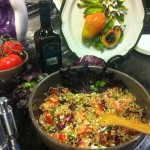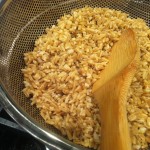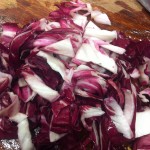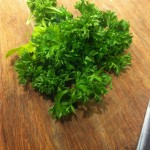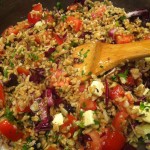Farro: The unknown italian grain
While I was living in Italy in the 90’s and 2000’s I was amazed how pasta and grains constituted a majority of the daily diet.
If you have ever traveled to Italy you know how different pastas are compared to what we are used to in the States. The Same applies for Grains.
Farro is the most popular grain to eat and holds a special place in Italian hearts for summer lunches, healthy eating and losing weight.
All one does is boil like rice, chill and serve with a variety of ingredients you find enjoyable; my favorite being artichoke hearts and pecorino fresco.
Farro is also added to soups to add a starch to the dish that will not become too mushy with long cooking like rice or pasta will.
Below is the recipe of the dish I prepare for my guests when we are walking around the countryside of Pienza Tuscany
Pienza-style Farro Salad (serves 4)
3 cups of rinsed organic Farro
2 teaspoons of seasalt
2 ripe tomato or cherry tomatoes
1/2 head of radicchio
1/2 bunch of organic chopped parsley
1/2 cup pitted mixed course chopped olives
1/2 cup of cheese such as cubed feta, pecorino, swiss etc
1/2 cup extra virgin olive oil
1/4 cup of red wine vinegar
1 teaspoon seasalt
Add the Farro into the pan, cover well with water, add salt and put on a light simmer. Cook for 30 mins
or until the Farro is tender to the teeth like al dente pasta. Drain and let cool.
Add all the rest of the ingredients (and you can add any other fresh ingredients you like!) and mix well.
Serve over fancy lettuce with a good white wine.
Can be made 1 day earlier.
<div style=’padding-bottom: 2px; line-height: 0px’><a href=’http://pinterest.com/pin/481674122616476660/’ target=’_blank’><img src=’http://media-cache-ec3.pinimg.com/550x/4d/07/67/4d0767d807c1feb9692ed85b1447f468.jpg’ border=’0′ width=’600′ height =’448’/></a></div><div style=’float: left; padding-top: 0px; padding-bottom: 0px;’><p style=’font-size: 10px; color: #76838b;’>Source: <a style=’text-decoration: underline; font-size: 10px; color: #76838b;’ href=’https://etcforthehome.com/2013/05/18/518-demo-tuscan-farro-salad/’>etcforthehome.com</a> via <a style=’text-decoration: underline; font-size: 10px; color: #76838b;’ href=’http://pinterest.com/bloomingtonchef/’ target=’_blank’>Dave</a> on <a style=’text-decoration: underline; color: #76838b;’ href=’http://pinterest.com’ target=’_blank’>Pinterest</a></p></div>
______________________
Farro, Italy’s Rustic Staple
New York Times Archives By SUZANNE HAMLIN Published: June 11, 1997
“FROM a cross-country reading of the culinary winds, it appears that farro, an ancient grain believed to have sustained the Roman legions, has finally made it to the New World. Used in soups, salads and desserts, the little light brown grain is an intriguing alternative to pasta and rice.
Not that farro hasn’t been in active use in Italy for the intervening centuries; it has, if only in a few central and northern Italian regions, where it is grown. These are relatively poor areas, where the longevity of the populace is sometimes attributed to regular farro consumption.
But now farro (pronounced FAHR-oh) appears to be moving from rustic tables into fashionable restaurants not only in Tuscany and northern Italy (where it suddenly seems ubiquitous on menus), but also in the United States, particularly on the West and East Coasts. Farro dishes are now regularly on the menus at high-profile restaurants like Union Square Cafe in Manhattan, Zuni Cafe in San Francisco, Chez Panisse in Berkeley, Calif., and Olivetto in Oakland, Calif.
Farro is not wheat, but a plant and grain all its own. A grain of farro looks and tastes somewhat like a lighter brown rice. It has a complex, nutty taste with undertones of oats and barley. But lacking the heaviness of many whole-wheat grains, farro tastes more elegant than earnest.”


